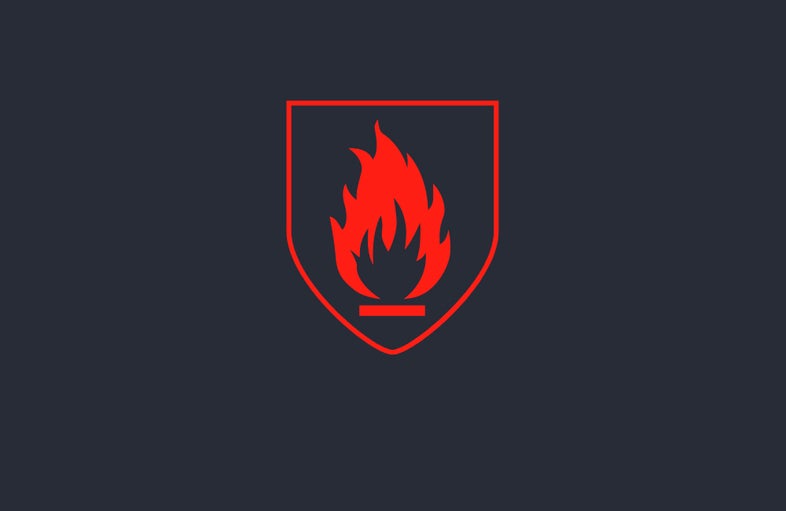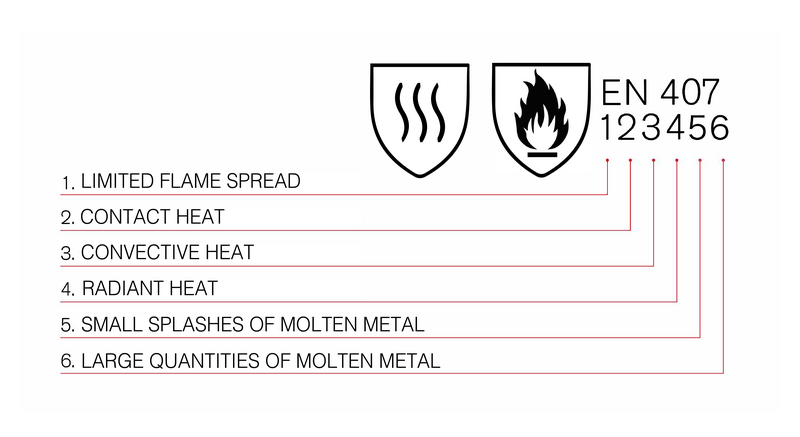
EN 407:2020 Protective gloves against thermal risks (Heat and/or fire)
Protective gloves against thermal risks (Heat and/or fire)
This standard specifies requirements and test methods for protective gloves that shall protect against thermal risks like heat and/or fire. There are 2 pictograms with clear differences between flame resistance and non-flame resistance.

Both pictograms may not be used at the same time.
The numbers given next to, or below, the pictogram indicates the gloves performance for each test in the standard. The higher number the better performance level.
X indicates that the protection level isn’t claimed.

1. LIMITED FLAME SPREAD
The limited flame spread test is used to assess the ability to protect the wearer’s hand if it comes close to a naked flame. The gloves don’t need to be non-flammable but they must inhibit combustion and burn slowly enough for the wearer to recognise this and safely remove the gloves. A whole glove sample is held vertically over a test burner with the flame in contact with the end of the middle finger of the glove. The after-flame and after-glow time is measured in this test. The standard doesn’t permitt the innermost surface of the test sample to show any sign of melting, complete holing of the sample or to come apart at the seams.
For high thermal resistant gloves (Levels 3 or 4), all outer materials different to the finger area must also be tested
| PERFORMANCE LEVEL | AFTER-FLAME TIME (s) |
AFTER GLOW-TIME (s) |
| 1 | ≤ 15 | no requirement |
| 2 | ≤ 1o | ≤ 120 |
| 3 | ≤ 3 | ≤ 25 |
| 4 | ≤ 2 | ≤ 5 |
2. CONTACT HEAT
Through conduction, heat is transferred within and through physical bodies. During use, the wearer of the gloves will intend to hold a hot item and the heat may transfer through the gloves and into the wearer’s hand. During the test is the glove exposed to temperatures between + 100°C up to + 500°C. It is measured how long it takes for the inner side of the glove to become 10°C warmer than it was from the beginning (about 25 °C degrees). The glove must withstand the increasing temperature of maximum 10°C for at least 15 seconds for an approval.
If not any other information is given, it is the palm that is tested.
| PERFORMANCE LEVEL | CONTACT TEMPERATURE TC (°C) | THRESHOLD TIME TT (s) |
| 1 | 100 | ≥ 15 |
| 2 | 250 | ≥ 15 |
| 3 | 350 | ≥ 15 |
| 4 | 500 | ≥ 15 |
3. CONVECTIVE HEAT
Convection is the mechanism of transfer of heat from the source to another place by the movement of fluids such as water or air. The samples are exposed to a heat source and it is measured how long it takes to increase the inside temperature of the glove with 24°C.
| PERFORMANCE LEVEL | HEAT TRANSFER INDEX HTI (s) |
| 1 | ≥ 4 |
| 2 | ≥ 7 |
| 3 | ≥ 10 |
| 4 | ≥ 18 |
4. RADIANT HEAT
Radiant heat is invisible but can be very intense. It can result in injuries or even spontaneous ignition before any conductive contact is made with the source. The average time is measured for a heat permeation of 2.5kW / m2.
| PERFORMANCE LEVEL | HEAT TRANSFER T24 (s) |
| 1 | ≥ 7 |
| 2 | ≥ 20 |
| 3 | ≥ 50 |
| 4 | ≥ 95 |
5. SMALL SPLASHES OF MOLTEN METAL
This test assess the degree of protection offered to the wearer’s hand from being struck by drops of molten metal, for example during metal grinding. When good test results, the droplets of molten metal do not stick on the surface of the test sample but tends to run off. This significantly reduces the time in which they are in contact and the temperature of the glove does not raise. Palm, back and cuff are tested if different materials or construction are present.The test result is based on the number of drops of molten metal that generates a temperature increase between the glove material and the skin with 40°C.
| PERFORMANCE LEVEL | NUMBER OF 0,5g DROPLETS |
| 1 | ≥ 10 |
| 2 | ≥ 15 |
| 3 | ≥ 25 |
| 4 | ≥ 35 |
6. LARGE QUANTITIES OF MOLTEN METAL
A PVC film is attached to the back of the glove material. Molten iron is poured onto the material. Folds in the material or seams on the outside of the glove can act as trapping points for the molten iron, so the gloves shall be designed to prevent the iron being retained. If any glove material ignites during the test it does’nt meet the requirement of this standard. The measurement consists of how many grams of molten iron required to damage the PVC film.
| PERFORMANCE LEVEL | MOLTEN IRON (g) |
| 1 | 30 |
| 2 | 60 |
| 3 | 120 |
| 4 | 200 |

